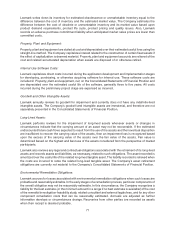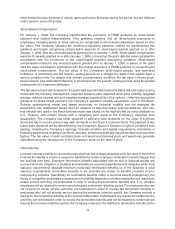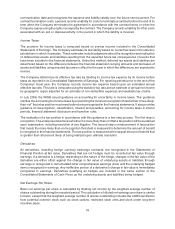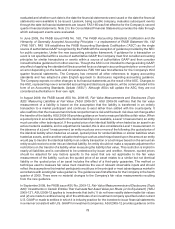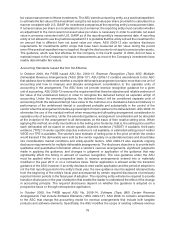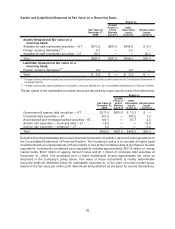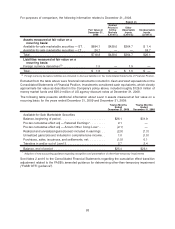Lexmark 2009 Annual Report Download - page 80
Download and view the complete annual report
Please find page 80 of the 2009 Lexmark annual report below. You can navigate through the pages in the report by either clicking on the pages listed below, or by using the keyword search tool below to find specific information within the annual report.other comprehensive earnings of certain gains and losses that arise during the period, but are deferred
under pension accounting rules.
Stock-Based Compensation:
On January 1, 2006, the Company implemented the provisions of FASB guidance on share-based
payment and related interpretations. This guidance requires that all share-based payments to
employees, including grants of stock options, be recognized in the financial statements based on their
fair value. The Company selected the modified prospective transition method for implementing this
guidance and began recognizing compensation expense for stock-based awards granted on or after
January 1, 2006, plus any unvested awards granted prior to January 1, 2006. Stock-based compensation
expense for awards granted on or after January 1, 2006, is based on the grant date fair value calculated in
accordance with the provisions of the share-based payment accounting guidance. Stock-based
compensation related to any unvested awards granted prior to January 1, 2006, is based on the grant
date fair value calculated in accordance with the original provisions of FASB guidance on accounting for
stock-based compensation. The fair value of the Company’s stock-based awards, less estimated
forfeitures, is amortized over the awards’ vesting periods on a straight-line basis if the awards have a
service condition only. For awards that contain a performance condition, the fair value of these stock-
based awards, less estimated forfeitures, is amortized over the awards’ vesting periods using the graded
vesting method of expense attribution.
The fair value of each option award on the grant date was estimated using the Black-Scholes option-pricing
model with the following assumptions: expected dividend yield, expected stock price volatility, weighted
average risk-free interest rate and weighted average expected life of the options. Under the accounting
guidance on share-based payment, the Company’s expected volatility assumption used in the Black-
Scholes option-pricing model was based exclusively on historical volatility and the expected life
assumption was established based upon an analysis of historical option exercise behavior. The risk-
free interest rate used in the Black-Scholes model was based on the implied yield currently available on
U.S. Treasury zero-coupon issues with a remaining term equal to the Company’s expected term
assumption. The Company has never declared or paid any cash dividends on the Class A Common
Stock and has no current plans to pay cash dividends on the Class A Common Stock. The payment of any
future cash dividends will be determined by the Company’s Board of Directors in light of conditions then
existing, including the Company’s earnings, financial condition and capital requirements, restrictions in
financing agreements, business conditions, tax laws, certain corporate law requirements and various other
factors. The fair value of each restricted stock unit award and deferred stock unit award was generally
calculated using the closing price of the Company’s stock on the date of grant.
Restructuring:
Lexmark records a liability for a cost associated with an exit or disposal activity at its fair value in the period
in which the liability is incurred, except for liabilities for certain employee termination benefit charges that
are accrued over time. Employee termination benefits associated with an exit or disposal activity are
accrued when the obligation is probable and estimable as a postemployment benefit obligation when local
statutory requirements stipulate minimum involuntary termination benefits or, in the absence of local
statutory requirements, termination benefits to be provided are similar to benefits provided in prior
restructuring activities. Specifically for termination benefits under a one-time benefit arrangement, the
timing of recognition and related measurement of a liability depends on whether employees are required to
render service until they are terminated in order to receive the termination benefits and, if so, whether
employees will be retained to render service beyond a minimum retention period. For employees who are
not required to render service until they are terminated in order to receive the termination benefits or
employees who will not provide service beyond the minimum retention period, the Company records a
liability for the termination benefits at the communication date. If employees are required to render service
until they are terminated in order to receive the termination benefits and will be retained to render service
beyond the minimum retention period, the Company measures the liability for termination benefits at the
74









